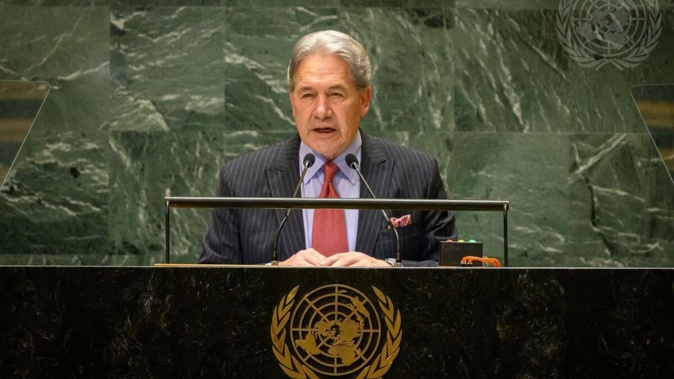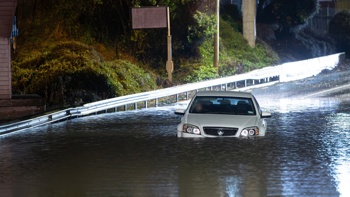
By Eloise Gibson of RNZ
Government coalition partner NZ First is refusing to say whether it would support New Zealand buying climate action from other countries.
Climate Change Minister Simon Watts admits there is no way to meet New Zealand’s commitments under the Paris Agreement without buying overseas help.
He didn’t directly answer when asked if this was a sticking point in the coalition.
Under the global climate agreement, all countries need to report back by the end of the year showing they are making adequate progress.
New Zealand’s pledge is cutting 41% off 2005 emissions by 2030, but is designed in such a way that the country has to make consistent emissions cuts throughout 2021-2030 – not just hit a target number in the year 2030.
Up to two-thirds of those total savings are expected to come from making deals with other nations, for example to retire a coal-fire furnace. Buying offshore help is a long-standing part of successive governments’ plans to achieve their targets, going back to John Key’s Government, which refused to commit to its Paris pledge until it was confirmed that countries could take advantage of buying help offshore.
Since there is currently no way for New Zealand to meet its first commitment under the global Paris Agreement without buying overseas help, NZ First’s reticence raises questions about whether New Zealand is on track to meet its global commitments.
The country needs to report back to the international community by the end of the year showing adequate progress, something all parties have to do.
Up to two-thirds of the total carbon savings are expected to come from making deals with other nations to cut carbon in their countries, for example retiring a coal-fired plant in Asia at lower cost than doing it here.
- Govt's latest carbon credit auction falls flat
- Emissions reduction plan focuses on "the big dots" to move NZ in "the right direction" - Simon Watts
Key’s Government fought hard on the international stage to be allowed to use international help, on the basis it would save New Zealand money compared with putting more pressure on farmers or industries to cut their emissions here.
NZ First went into the election saying it did not want this money spent overseas – and recently Government figures have avoided saying outright that they will make the purchases – despite saying they would meet the Paris target.
When RNZ asked NZ First: “Is buying offshore credits to meet the target something NZ First would agree to as a coalition partner?” the party took almost four days to respond before coming back with “no comment”.
Watts did not directly address a question from RNZ about whether paying other countries to take action was a sticking point between the coalition of governing parties.
In a statement he said: “Tough decisions will need to be made, and we are considering all options” including offshore purchases.
The third coalition party, Act, supports offshore trading in carbon credits, the party confirmed, though it has previously been relaxed about whether New Zealand met its international climate pledge.
The Government has repeatedly said it is committed to meeting the target, known as an NDC (Nationally Determined Contribution).
In his statement last week, Watts acknowledged the country cannot meet the target without some overseas contribution – and acknowledged that successive Governments had always expected to buy in help from offshore.
“Domestic action continues to be prioritised. However, the scale of emission reductions required to meet the first NDC is greater than what’s feasible through domestic action alone,” he said.
He said New Zealand had signed high-level memorandums of understanding on potential offshore trading with Singapore, the Philippines and Thailand when he and Prime Minister Christopher Luxon visited those countries in April.
How did we get here?
Time is running out to ink climate deals, with countries such as Switzerland and Singapore beginning to sign two-way agreements. New Zealand is among the most reliant on these deals in the world, with most countries doing the majority of their climate work inside their borders. Foreign affairs officials have warned Watts the price of every tonne could rise fivefold if the Government waits until close to 2030 to buy help, because of a last-minute scramble for deals.
The 2015 Paris Agreement required all countries to set targets for 2021-2030 representing their “maximum ambition”.
Every country was supposed to do its part to keep the planet inside 1.5C to 2C of heating from greenhouse gases, with developed countries making the deepest cuts because of their historical emissions.
Nations agreed to 1.5C-2C as the maximum, to avoid steeply worsening heatwaves, storms, droughts, crop failures and increased climate refugees.
New Zealand’s former lead climate negotiator Kay Harrison told the Climate Change and Business Conference last month that back in 2014, when country targets were first being negotiated, New Zealand fought to be allowed to count offshore action towards its target. This was on the basis it was cheaper and less damaging to the New Zealand economy.
New Zealand’s position has traditionally been that with half its emissions not covered by carbon pricing, in the form of farming gases, historically slow progress on transport, and an already-mainly-clean electricity sector, making domestic cuts as steep as the likes of the United Kingdom would be too difficult.
Harrison said New Zealand went so far as to make its initial, draft Paris pledge conditional on being allowed to buy help offshore, through carbon trading or direct purchases.
At the time, Harrison said trust in international carbon trading was low because countries had used “hot air credits” to get away with actually increasing emissions in their own countries, under Paris’ predecessor the Kyoto protocol. Small island nations were particularly wary.
“There was a very strong movement to say the only reductions that should ever count were the ones you did in your own country,” Harrison said.
But she said that restriction would not have been helpful, because poorer countries didn’t have the money to cut their emissions quickly enough, while some rich countries would have run up against limits to what they could afford at home.
“The alternatives to purchasing offshore for us would have for us been incredibly costly,” Harrison told the conference.
Harrison said making a less ambitious pledge was not an option.
“I’ve heard a lot of people say we should have only set a target we could manage to do domestically – we didn’t have that choice because this was our third target [under various climate agreements] and there was an agreement your target would always be greater than your last one.
“So the Government of the day was between a rock and a hard place, do we shut down industry, do we kill the cows – no, we could deliver a volume of reductions that was fair and not kill the economy.”
Harrison said at the time John Key’s Government expected to purchase about 200 million tonnes – more than double is expected today, despite the fact that Jacinda Ardern’s Government has since strengthened the 2030 target from 30% to 41%.
“It was very scary, it was very hard for the government of the day, because at that time there were no markets, but they agreed to a target that was everything we could do domestically and 200 million tonnes.
“Wind the clock forward and it’s more like 90 million – last year’s projections were looking more like 60 with tailwinds, before some of the recent policy decisions we made. That’s less than half what we thought, and we have a more ambitious target than we did in 2015.”
Harrison said New Zealand was in danger of forgetting why it wanted overseas purchases in the first place.
“Paris requires you to be as ambitious as you can be,” she said.
“We genuinely displayed that ambition but we have received a lot of criticism ever since for being a country that had chosen this pathway [of buying from overseas].”
“New Zealanders are in danger of forgetting their history, forgetting what they signed up to and are now saying, ‘Why should we pay?’”
Two-part target under question
Complying with their Paris NDCs has been written into New Zealand free trade deal with Europe – and some diplomats have said that if New Zealand looks like it’s reneging, it could open the way for other countries to back away from doing their best to meet commitments.
New Zealand’s target was designed to be met in two ways: cutting emissions as much as possible inside the country by meeting a set of five yearly ‘emissions budgets’, and buying carbon credits from overseas.
As well as two-way deals between countries, the Paris Agreement also allows direct linking of Emissions Trading Schemes in different countries – but so far New Zealand’s market is not linked to any other country.
The Government could reduce the need for buying those 100 million tonnes of carbon savings if New Zealand over-performed on cutting its own emissions between now and 2030.
But as of 2024, it is barely on track.
Currently the Government is looking like it will barely meet its carbon budgets at home from now until 2030, prompting independent watchdogs to raise the alarm about the lack of wriggle room.
Treasury has said the costs of buying overseas action would be “significant” and will start biting “within the current fiscal forecast period” – with a starting price of around $4 billion tonnes for the 2021-2030 decade.
The cost is likely to rise the longer the Government leaves it, foreign affairs officials have told Watts.
But as time runs down it appears the political reality of spending the money is causing discomfort. Government figures have equivocated about where the money will come from and when, and even baulked at saying they will definitely spend it.
At the Climate Change and Business Conference in Auckland Watts was asked to confirm the Government would buy the credits it needed offshore to meet the Paris target.
He replied that in “voterland” if he said writing a cheque for $4 billion of taxpayer money overseas...”the political reality of writing a cheque to someone overseas...I don’t think it’s realistic”.
Watts told the conference he was “doing everything” he could to as much of the target as possible at home but “even if I do everything I can in the next 65 months” it would not be enough to get there.
He implied this was a hangover of inaction by the Labour Government, saying “We inherited a gap of about 100 million tonnes and we didn’t inherit a plant that would meet that target” – a claim he repeated to RNZ last week.
However, although Labour did not sign any deals before being voted out, former Minister James Shaw had openly outlined dates by which he hoped to close the first deal, and got government officials involved in the legwork for bilateral deals.
Pressed on this, Watts confirmed successive governments had always planned to buy credits and offshore purchases were necessary,
He also confirmed he was aware of advice from officials that these credits could cost five times more if they are purchased close to 2030.
After the conference, comments about offshore spending being “unrealistic” prompted a response on social media from Catherine Leining of think tank Motu, an expert in carbon trading.
“NZ’s Minister of Climate Change referred to funding offshore mitigation to bridge the NDC gap as politically ‘unrealistic’,” she said.
“So far, it has proven realistic for the 11 buyer countries and 48 host countries that have negotiated 90 bilateral agreements to transfer mitigation under ... the Paris Agreement.
“The minister is correct that previous Governments have kicked the can to his doorstep and time is short. It is encouraging this Government is keeping options open and recently announced co-operation initiatives with Thailand, Singapore and the Philippines.”
Take your Radio, Podcasts and Music with you









